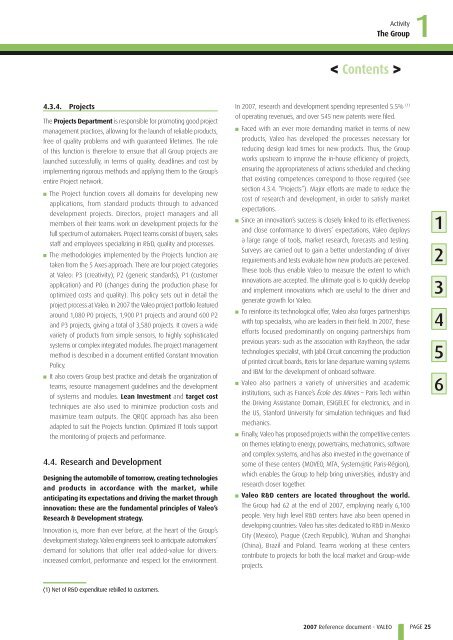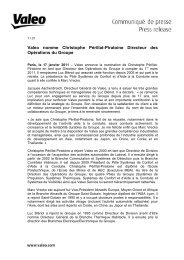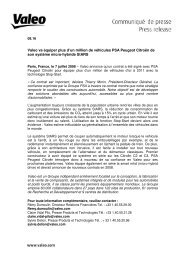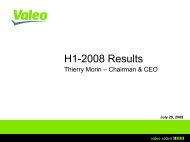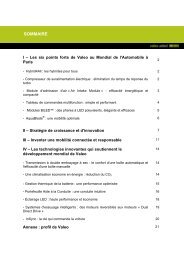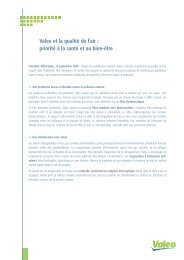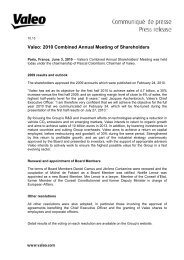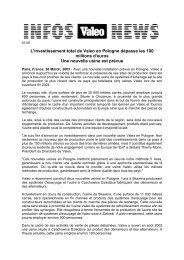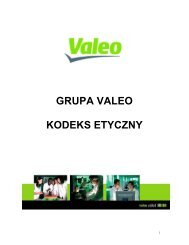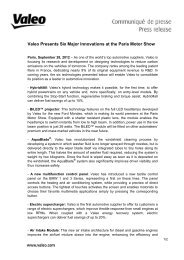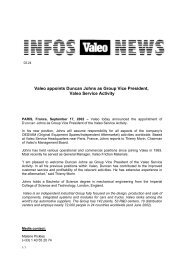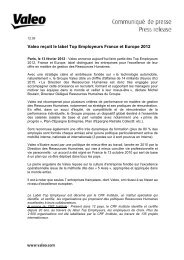2007 Reference document (PDF) - Valeo
2007 Reference document (PDF) - Valeo
2007 Reference document (PDF) - Valeo
Create successful ePaper yourself
Turn your PDF publications into a flip-book with our unique Google optimized e-Paper software.
4.3.4. Projects<br />
The Projects Department is responsible for promoting good project<br />
management practices, allowing for the launch of reliable products,<br />
free of quality problems and with guaranteed lifetimes. The role<br />
of this function is therefore to ensure that all Group projects are<br />
launched successfully, in terms of quality, deadlines and cost by<br />
implementing rigorous methods and applying them to the Group’s<br />
entire Project network.<br />
■<br />
■<br />
■<br />
The Project function covers all domains for developing new<br />
applications, from standard products through to advanced<br />
development projects. Directors, project managers and all<br />
members of their teams work on development projects for the<br />
full spectrum of automakers. Project teams consist of buyers, sales<br />
staff and employees specializing in R&D, quality and processes.<br />
The methodologies implemented by the Projects function are<br />
taken from the 5 Axes approach. There are four project categories<br />
at <strong>Valeo</strong>: P3 (creativity), P2 (generic standards), P1 (customer<br />
application) and P0 (changes during the production phase for<br />
optimized costs and quality). This policy sets out in detail the<br />
project process at <strong>Valeo</strong>. In <strong>2007</strong> the <strong>Valeo</strong> project portfolio featured<br />
around 1,080 P0 projects, 1,900 P1 projects and around 600 P2<br />
and P3 projects, giving a total of 3,580 projects. It covers a wide<br />
variety of products from simple sensors, to highly sophisticated<br />
systems or complex integrated modules. The project management<br />
method is described in a <strong>document</strong> entitled Constant Innovation<br />
Policy.<br />
It also covers Group best practice and details the organization of<br />
teams, resource management guidelines and the development<br />
of systems and modules. Lean Investment and target cost<br />
techniques are also used to minimize production costs and<br />
maximize team outputs. The QRQC approach has also been<br />
adapted to suit the Projects function. Optimized IT tools support<br />
the monitoring of projects and performance.<br />
4.4. Research and Development<br />
Designing the automobile of tomorrow, creating technologies<br />
and products in accordance with the market, while<br />
anticipating its expectations and driving the market through<br />
innovation: these are the fundamental principles of <strong>Valeo</strong>’s<br />
Research & Development strategy.<br />
Innovation is, more than ever before, at the heart of the Group’s<br />
development strategy. <strong>Valeo</strong> engineers seek to anticipate automakers’<br />
demand for solutions that offer real added-value for drivers:<br />
increased comfort, performance and respect for the environment.<br />
(1) Net of R&D expenditure rebilled to customers.<br />
<strong>2007</strong> <strong>Reference</strong> <strong>document</strong> - VALEO<br />
Activity<br />
The Group<br />
In <strong>2007</strong>, research and development spending represented 5.5% (1)<br />
of operating revenues, and over 545 new patents were filed.<br />
■<br />
■<br />
■<br />
■<br />
■<br />
■<br />
< Contents ><br />
Faced with an ever more demanding market in terms of new<br />
products, <strong>Valeo</strong> has developed the processes necessary for<br />
reducing design lead times for new products. Thus, the Group<br />
works upstream to improve the in-house efficiency of projects,<br />
ensuring the appropriateness of actions scheduled and checking<br />
that existing competences correspond to those required (see<br />
section 4.3.4. “Projects”). Major efforts are made to reduce the<br />
cost of research and development, in order to satisfy market<br />
expectations.<br />
Since an innovation’s success is closely linked to its effectiveness<br />
and close conformance to drivers’ expectations, <strong>Valeo</strong> deploys<br />
a large range of tools, market research, forecasts and testing.<br />
Surveys are carried out to gain a better understanding of driver<br />
requirements and tests evaluate how new products are perceived.<br />
These tools thus enable <strong>Valeo</strong> to measure the extent to which<br />
innovations are accepted. The ultimate goal is to quickly develop<br />
and implement innovations which are useful to the driver and<br />
generate growth for <strong>Valeo</strong>.<br />
To reinforce its technological offer, <strong>Valeo</strong> also forges partnerships<br />
with top specialists, who are leaders in their field. In <strong>2007</strong>, these<br />
efforts focused predominantly on ongoing partnerships from<br />
previous years: such as the association with Raytheon, the radar<br />
technologies specialist, with Jabil Circuit concerning the production<br />
of printed circuit boards, Iteris for lane departure warning systems<br />
and IBM for the development of onboard software.<br />
<strong>Valeo</strong> also partners a variety of universities and academic<br />
institutions, such as France’s École des Mines – Paris Tech within<br />
the Driving Assistance Domain, ESIGELEC for electronics, and in<br />
the US, Stanford University for simulation techniques and fluid<br />
mechanics.<br />
Finally, <strong>Valeo</strong> has proposed projects within the competitive centers<br />
on themes relating to energy, powertrains, mechatronics, software<br />
and complex systems, and has also invested in the governance of<br />
some of these centers (MOVEO, MTA, System@tic Paris-Région),<br />
which enables the Group to help bring universities, industry and<br />
research closer together.<br />
<strong>Valeo</strong> R&D centers are located throughout the world.<br />
The Group had 62 at the end of <strong>2007</strong>, employing nearly 6,100<br />
people. Very high level R&D centers have also been opened in<br />
developing countries: <strong>Valeo</strong> has sites dedicated to R&D in Mexico<br />
City (Mexico), Prague (Czech Republic), Wuhan and Shanghai<br />
(China), Brazil and Poland. Teams working at these centers<br />
contribute to projects for both the local market and Group-wide<br />
projects.<br />
1<br />
PAGE 25<br />
1<br />
2<br />
3<br />
4<br />
5<br />
6


